Abstract
In Mexico there are significant advances regarding the expansion of educational services, but they have not produced a decrease in school desertion or an increase in terminal efficiency. In this article, we analyze the performance of primary education in the Mexican states by applying a nonparametric technique called Free Disposal Hull (FDH). With this tool, we aim to identify the appropriate public expenditure to reach certain objectives in the education field and determine if the present expenditure is being used efficiently, that is, if the best results in education are being obtained at the same cost or at the lowest possible cost.
References
Afonso, António, Ludger Schuknecht y Vito Tanzi. 2006. Public Sector Efficiency. Evidence for New eu Member States and Emerging Markets. Working papers series no. 581. Frankfurt: European Central Bank.
Afonso, António y Miguel St. Aubyn. 2005. Non–Parametric Approaches to Education and Health Efficiency in OECD Countries. Journal of Applied Economics VIII (2): 227–246.
Clements, Benedict. 1999. The Efficiency of Education Expenditure in Portugal. IMF Working paper no. 179. Washington: International Monetary Fund.
Comisión Económica para América Latina (CEPAL). 2000. Desarrollo: más allá de la economía. Informe 2000. Progreso económico y social en América Latina. Washington: Banco Interamericano de Desarrollo.
Consejo Nacional de Población. 2007. Nuevas proyecciones de la población 2006–2050 basadas en el conteo de 2005. México: CONAPO.
Gupta, Sanjeev, Keiko Honjo y Martin Verhoeven. 1997. The Efficiency of Government Expenditure: Experiences from Africa. Working paper no. 153. Washington: International Monetary Fund.
Instituto Nacional para la Evaluación Educativa. 2006. Panorama educativo de México 2006. http://www.inee.edu.mx/images/stories/Panorama 2006/01–panorama2006web.pdf (28 de mayo de 2007).
–––––––––– 2006. La calidad de la educación básica ayer, hoy y mañana. http://www.inee.edu.mx/images/stories/documentos_pdf/ Publicaciones/Informe2006/4oinfresejecutivo.pdf (28 de mayo de 2007).
Machado, Roberto. 2006. ¿Gastar más o gastar mejor? La eficiencia del gasto público en América Central y República Dominicana. Banco Interamericano de Desarrollo. http://idbdocs.iadb.org/wsdocs/getdocument.aspx ?docnum=858986 (9 de octubre de 2007).
Moesen, Wim y Annick Persoons. 2002. Measuring and Explaining the Productive Efficiency of Tax Offices: A Non–Parametric Best Practice Frontier Approach. Tijdschrift voor Economie en Management XLVII (3): 399–416.
Organización para la Cooperación y el Desarrollo Económico (OCDE). 2006. Education at Glance 2006. http://www.oecd.org/document/6/0,2340, en_2649_201185_37344774_1_1_1_1,00.html (9 de octubre de 2007).
–––––––––– 2003. What PISA produces–PISA 2003. http://www.oecd.org/pages/0,3417,en_32252351_32236173_1_1_1_1_1,00.html (9 de octubre de 2007).
Ravallion, Martin. 2003. On Measuring Aggregate "Social Efficiency". Policy research working paper 3166. Washington: World Bank.
Secretaría de Educación Pública. 2006. sep 1 Etapa. En Informe de rendición de cuentas de la Administración 2000–2006. Secretaría de la Función Pública. http://www.sep.gob.mx/wb2/sep/sep_Primera_Etapa1 (9 de octubre de 2007).
–––––––––– Varios años. Estadísticas educativas del Sistema Nacional de Información Educativa. http://www.sep.gob.mx/work/appsite/xesta–dos/index.htm (9 de octubre de 2007).
St. Aubyn, Miguel. 2002. Evaluating Efficiency in the Portuguese Health and Education Sectors. Ponencia presentada en Portuguese Economic Development in the European Context: Determinants and Policies–Proceedings, Bank of Portugal Conference.
Thrall, Robert M. 1999. What is the Economic Meaning of FDH? Journal of Productivity Analysis 11(3): 243–250.
Tandon, Ajay 2005. Measuring Efficiency of Macro Systems: An Application to Millennium Development Goal Attainment. Asian Development Review 22 (2): 108–125.
Tanzi, Vito. 2000. The Role of the State and Quality of the Public Sector. IMF Working paper no. 36. Washington: International Monetary Fund.
Open access policy
The authors who publish in región y sociedad accept the following conditions:
In accordance with the copyright laws, región y sociedad recognizes and respects the authors’ moral rights, as well as the ownership of property rights, which will be transferred to the journal to disseminate the articles in open access. región y sociedad does not charge the authors for submitting and processing articles for publication.
All the texts published by región y sociedad —with no exception— are distributed under a Creative Commons license 4.0 Attribution – Noncommercial (CC BY-NC 4.0 International), which allows third parties to use the publication as long as they mention the works’ authorship and the first publication in this journal.
The authors can enter into independent and additional contractual agreements for the nonexclusive distribution of the version of the article published in región y sociedad (for instance include it into an institutional repository or publish it in a book) as long as they clearly indicate that the work was published for the first time in región y sociedad.
For all the above, the author(s) must send the Letter of transfer of property rights of the first publication duly filled in and signed by the author(s). This letter can be sent by e-mail as a PDF to: region@colson.edu.mx

